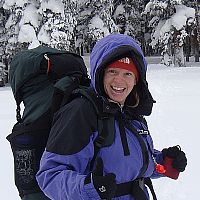Mitra & Papuga, 2012
Toward an improved understanding of the role of transpiration in critical zone dynamics
Mitra B. and Papuga S. A. (2012)
Abstract H53I-1650 presented at 2012 Fall Meeting, AGU, San Francisco, Calif., 3-7 Dec (Poster)
-
Catalina-Jemez, INVESTIGATOR
-
Catalina-Jemez, INVESTIGATOR
Abstract
Evapotranspiration (ET) is an important component of the total water balance across any ecosystem. In subalpine mixed-conifer ecosystems, transpiration (T) often dominates the total water flux and therefore improved understanding of T is critical for accurate assessment of catchment water balance and for understanding of the processes that governs the complex dynamics across critical zone (CZ). The interaction between T and plant vegetation not only modulates soil water balance but also influences water transit time and hydrochemical flux – key factors in our understanding of how the CZ evolves and responds. Unlike an eddy covariance system which provides only an integrated ET flux from an ecosystem, a sap flow system can provide an estimate of the T flux from the ecosystem. By isolating T, the ecohydrological drivers of this major water loss from the CZ can be identified. Still, the species composition of mixed-conifer ecosystems vary and the drivers of T associated with each species are expected to be different. Therefore, accurate quantification of T from a mixed-conifer requires knowledge of the unique transpiration dynamics of each of the tree species. Here, we installed a sap flow system within two mixed-conifer study sites of the Jemez River Basin – Santa Catalina Mountains Critical Zone Observatory (JRB – SCM CZO). At both sites, we identified the dominant tree species and installed sap flow sensors on healthy representatives for each of those species. At the JRB CZO site, sap sensors were installed in fir (4) and spruce (4) trees, at the SCM CZO site, sap sensors were installed at white fir (4) and maple (4) and one dead tree. Meteorological data as well as soil temperature (Ts) and soil moisture (θ) at multiple depths were also collected from each of the two sites. Preliminary analysis of two years of sap flux rate at JRB – SCM CZO shows that the environmental drivers of fir, spruce, and maple are different and also vary throughout the year. For JRB fir, during the snowmelt period, Ts across multiple depths was the primary control on the sap flux rate (R2 ≈ 0.7). During the dry and monsoon periods only net radiation (Rn) was found to be a driver of the flux rate (R2 ≈ 0.4). For JRB spruce, a combination of Ts across multiple depths as well as air temperature (R2 ≈ 0.5) were the dominant drivers of sap flux rate during the snowmelt period. During the monsoon period, Rn (R2 ≈ 0.4) was the dominant driver. For SCM maple, during the dry period, θ across multiple depths was the primary driver of the sap flux rate (R2 ≈ 0.8), the strength of the correlation with the control of θ on sap flux rate drastically dropping (R2 ≈ 0.2) during the monsoon period. For SCM white fir, θ across multiple depths was a weak driver of sap flux rate during the dry (R2 ≈ 0.1) and monsoon periods (R2 ≈ 0.2). This study highlights the importance of species-specific information for understanding the role of transpiration in critical zone processes. Specifically, unique environmental drivers that vary throughout the year for different vegetation types complicate the assessment of both catchment-scale water and carbon balances and for understanding of the processes that govern the complex dynamics across the CZ.
Citation
Mitra B. and Papuga S. A. (2012): Toward an improved understanding of the role of transpiration in critical zone dynamics. Abstract H53I-1650 presented at 2012 Fall Meeting, AGU, San Francisco, Calif., 3-7 Dec (Poster).
Explore Further


